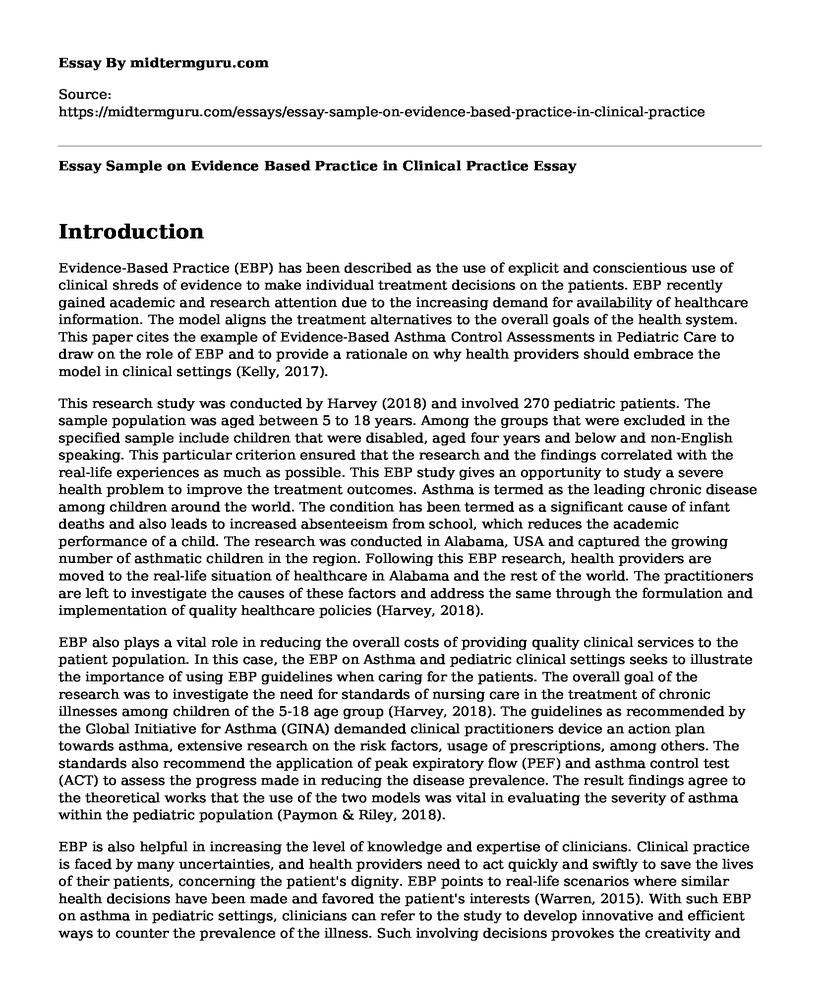Introduction
Evidence-Based Practice (EBP) has been described as the use of explicit and conscientious use of clinical shreds of evidence to make individual treatment decisions on the patients. EBP recently gained academic and research attention due to the increasing demand for availability of healthcare information. The model aligns the treatment alternatives to the overall goals of the health system. This paper cites the example of Evidence-Based Asthma Control Assessments in Pediatric Care to draw on the role of EBP and to provide a rationale on why health providers should embrace the model in clinical settings (Kelly, 2017).
This research study was conducted by Harvey (2018) and involved 270 pediatric patients. The sample population was aged between 5 to 18 years. Among the groups that were excluded in the specified sample include children that were disabled, aged four years and below and non-English speaking. This particular criterion ensured that the research and the findings correlated with the real-life experiences as much as possible. This EBP study gives an opportunity to study a severe health problem to improve the treatment outcomes. Asthma is termed as the leading chronic disease among children around the world. The condition has been termed as a significant cause of infant deaths and also leads to increased absenteeism from school, which reduces the academic performance of a child. The research was conducted in Alabama, USA and captured the growing number of asthmatic children in the region. Following this EBP research, health providers are moved to the real-life situation of healthcare in Alabama and the rest of the world. The practitioners are left to investigate the causes of these factors and address the same through the formulation and implementation of quality healthcare policies (Harvey, 2018).
EBP also plays a vital role in reducing the overall costs of providing quality clinical services to the patient population. In this case, the EBP on Asthma and pediatric clinical settings seeks to illustrate the importance of using EBP guidelines when caring for the patients. The overall goal of the research was to investigate the need for standards of nursing care in the treatment of chronic illnesses among children of the 5-18 age group (Harvey, 2018). The guidelines as recommended by the Global Initiative for Asthma (GINA) demanded clinical practitioners device an action plan towards asthma, extensive research on the risk factors, usage of prescriptions, among others. The standards also recommend the application of peak expiratory flow (PEF) and asthma control test (ACT) to assess the progress made in reducing the disease prevalence. The result findings agree to the theoretical works that the use of the two models was vital in evaluating the severity of asthma within the pediatric population (Paymon & Riley, 2018).
EBP is also helpful in increasing the level of knowledge and expertise of clinicians. Clinical practice is faced by many uncertainties, and health providers need to act quickly and swiftly to save the lives of their patients, concerning the patient's dignity. EBP points to real-life scenarios where similar health decisions have been made and favored the patient's interests (Warren, 2015). With such EBP on asthma in pediatric settings, clinicians can refer to the study to develop innovative and efficient ways to counter the prevalence of the illness. Such involving decisions provokes the creativity and individual skills of the clinicians hence making their jobs more interesting each day. The greatest achievement for a clinical officer is to learn that their research or arguments were used to enhance healthcare services across the communities. In the long run, this sense of fulfillment improves the clinician's job satisfaction and reduces the rate of employee turnover in hospital settings (Kelly, 2017).
References
Harvey, M. (2018). Evidence-Based Asthma Control Assessments in Pediatric Care. Pediatric Nursing, 44(4), 163-168.
Kelly, L. (2017). Reconceptualizing professional knowledge: the changing role of knowledge and evidence in social work practice. Social Work Education, 36(3), 245-256.
Paymon, L. S., & Riley, P. (2018). Caregivers' Perception of Asthma Control In Children. Pediatric Nursing, 44(1), 17-37.
Warren, E. (2015). Evidence-based practice. Practice Nurse, 45(12), 27-32.
Cite this page
Essay Sample on Evidence Based Practice in Clinical Practice. (2022, Oct 27). Retrieved from https://midtermguru.com/essays/essay-sample-on-evidence-based-practice-in-clinical-practice
If you are the original author of this essay and no longer wish to have it published on the midtermguru.com website, please click below to request its removal:
- Reduction of Obesity - Paper Example
- Nursing Essay Example: Engaging Patients With Bariatric Surgery
- Essay on Food Politics
- Social Work Graduate School Personal Statement
- Successful Interview: Jane's Story of Quitting Drug Addiction - Essay Sample
- Anxiety in Autism: Mediating Role in Academic Behaviour & Skills Development - Research Paper
- Bones: Essential for Human Support, Shape & Protection - Essay Sample







